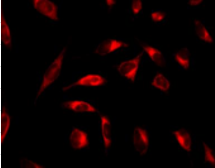BioActs offers the full spectrum of fluorescent dyes such as FSD FluorTM, Flamma® Fluors, ICG, and Other Dyes,
and also offers Fluorescent Quenchers, Crosslinkers, Fluorescent Antibodies, Bioprobes,
and Microspheres, Magnetic Beads, Dye Labeling Kit, etc.
Cell Structure Analysis Probes
MitoFlamma® series
MitoFlamma® series is a mitochondria-selective fluorescent dye that allows to detect mitochondrial morphology in living cells. This unique dye appears to preferentially accumulate in mitochondria regardless of mitochondrial membrane potential in certain cell types, making it a possible tool for determining mitochondrial mass. MitoFlamma® series enables researchers to observe mitochondrial activity, localization and abundance as well as monitoring the effect of drugs or other external stimuli on the mitochondrial function. Once mitochondria are labeled with this special dye, the cells can be treated with an aldehyde fixative for samples that require fixation for further processing. MitoFlamma® series probes are retained in the mitochondria during the fixation step and after permeabilization with some detergents during subsequent processing steps. After fixation, labeled samples can be applied in a variety of experiments such as immunocytochemistry, in situ hybridization, microplate-based analysis, etc.

Figure 1. Imaging of MitoFlamma® Green and MitoFlamma® Deep Red mitochondria staining
CytoFlamma® series
The analysis of live cell membranes and liposome bilayers represents a significant area of application for fluorescent probes. Lipophilic organic dyes bear some structural resemblance to natural lipids and can be incorporated into cell wall and liposome. BioActs developed CytoFlamma® cell membrane series as versatile membrane selective fluorescent probes. The probes consist of Flamma dye attached with hydrophobic lipid analogs. They can be used in studies for biophysical analysis of membranes, for tracing lipid transport and metabolism in live cells, and for lipid-mediated signal transduction processes. Flamma® dyes display strong absorption, high fluorescence quantum yield and high photostability, and they maintain good fluorescence activity and stability after conjugation to biomolecules. Due to low toxicity and stable retention, CytoFlamma® cell membrane probes might be useful for long-term cell tracing and can be used as membrane markers of endocytosis and exocytosis. The probes are stable under photooxidation effects induced by ultraviolet excitation and are resistant to spontaneous oxidation. We offer CytoFlamma® cell membrane series as selective fluorescent probes for analyzing cell structure by incorporating into plasma membrane.
Figure 2. Imaging of CytoFlamma® 488 cell membrane staining
Detaching HeLa cell from plate and treating CytoFlamma®488 cell membrane and staining for 5 min, then divided to plate again and cultivated for 24 h, image obtained with FITC filter
Figure 3. Imaging of cultured cell after CytoFlamma® cell membrane staining
Image obtained from cell cultivation after staining HeLa cell treated with CytoFlamma® series. (a) CytoFlamma® 496 (green) and CytoFlamma® 648 (red). (b) CytoFlamma® 552(yellow) and CytoFlamma® 648 (red)
| Product | Usage | Description |
|---|---|---|
Cytoskeleton
|
Availability : Imaging for cytoskeleton | Reacting Functionality : Filamentous actin(F-actin) labeling probe |
Plasma Membrane
|
Availability : Imaging for plasma membrane | Reacting Functionality : Fluorescence dye for labeling hydrophobic structures in membranes |
Mitochondria
|
Availability : Imaging for mitochondria | Reacting Functionality : Mitochondria-selective green fluorescent dye |

 log
log My
My Contact
Contact